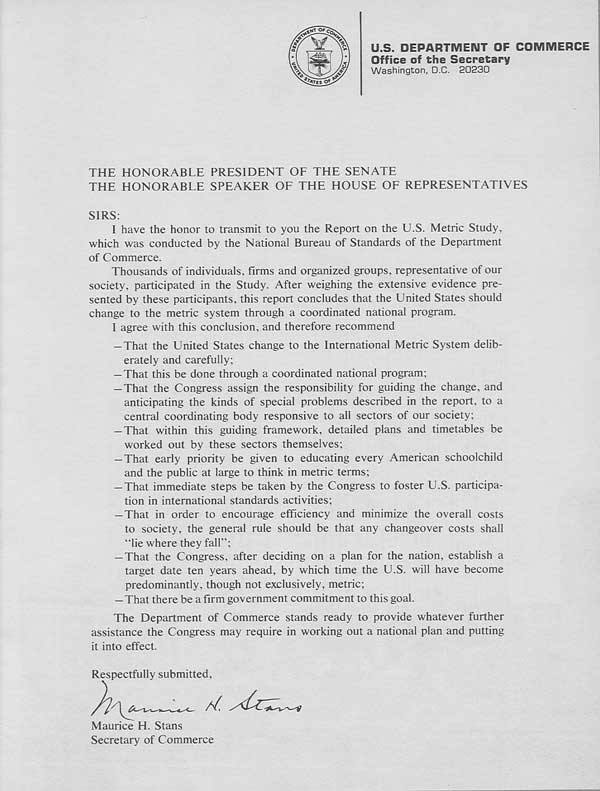In a late-1960s project that would later be described by Lewis Branscomb as the biggest National Bureau of Standards project of his directorship, the Bureau embarked on the U.S. Metric Study. In the Metric Study Act of 1968 (Pub. L. 90-472, Aug. 9, 1968, 82 Stat. 693), Congress directed the Secretary of Commerce to conduct an extensive study to determine the advantages and disadvantages of increased metric use in the United States and to submit a full report to Congress within three years. The Secretary of Commerce delegated responsibility for the study to NBS.
What the law said
From 15 USC 204 Notes:
STUDY OF METRIC SYSTEM BY THE SECRETARY OF COMMERCE
Pub. L. 90-472, Aug. 9, 1968, 82 Stat. 693, authorized the Secretary of Commerce to conduct a program of investigation, research, and survey to determine the impact of increasing worldwide use of the metric system on the United States; to appraise the desirability and practicability of increasing the use of metric weights and measures in the United States; to study the feasibility of retaining and promoting by international use of dimensional and other engineering standards based on the customary measurement units of the United States; and to evaluate the costs and benefits of alternative courses of action which might be feasible for the United States. The Secretary was directed to submit to the Congress such interim reports as he deemed desirable, and within three years after Aug. 9, 1968, a full and complete report of the findings made under the study, together with such recommendations as he considered to be appropriate and in the best interests of the United States. By its own terms, the Act expired thirty days after the submission of the final report.
About the study
[The following is from Publications Taking Us Toward a Metric America by Ralph A. Richter in NIST Special Publication 958, A Century of Excellence in Measurements, Standards, and Technology: A Chronicle of Selected NBS/NIST Publications, 1901-2000.]
The Metric Study Group was directed by Daniel De Simone with a team of over 40 NBS program managers and supporting staff. Also heavily involved in the study were 50 private-sector members of a Metric System Study Advisory Panel. The panel members were appointed by the Secretary of Commerce from organizations representing a wide spectrum of interests. The chairman of the panel was Louis Polk, a director of the Bendix Corporation.
Following a detailed blueprint, the study sought facts and opinions from over 700 major groups representing every sector of society — including labor unions, trade associations, professional societies, education associations, consumer-related organizations, and many others. Input was obtained through a series of multi-day public hearings, surveys, correspondence, and other supplementary investigations.
The report to Congress was published as a 190-page NBS Special Publication entitled A Metric America: A Decision Whose Time Has Come. Intended for wide distribution, this landmark publication details the findings and conclusions of the U.S. Metric Study. The report includes several specific recommendations for the Nation to achieve a smooth and coordinated transition to the metric system of measurement. Many of these recommendations were summarized in the repot’s transmittal letter to Congress which was signed by Secretary of Commerce Maruice H. Stans. This letter is reproduced below.

In addition to the main summary report, 12 supporting volumes were produced as part of the project — for a grand total of over 2300 pages of published text. These supporting volumes were entitled:
- International Standards (NBS SP 345-1)
- Federal Government: Civilian Agencies (345-2)
- Comercial Weights and Measures (345-3)
- The Manufacturing Industry (345-4)
- Nonmanufacturing Business (345-5)
- Education (345-6)
- The Consumer (345-7)
- International Trade (345-8)
- Department of Defense (345-9)
- A History of the Metric System Controversy in the United States (345-10)
- Engineering Standards (345-11)
- Testimony of Nationally Representative Groups (345-12).
Because of its importance as the summary document of the most significant study on national metrication issues ever conducted by the United Staets government, the Metric America publication has been (and continues to be) cited as a reference in hundreds of books, magazines, and newspaper articles — the current edition of Encyclopedia Britannica being one example.
The report was cited heavily when the 92nd and the 93rd Congresses debated legislative proposals and national conversion issues. Finally, four years after the report was first published, the Metric Conversion Act was passed by the 94th Congress in 1975 and signed into law by President Ford. The Act was an important milestone, yet disappointing to many of the U.S. Metric Study contributors because several of the report’s recommendations — such as the importance of a carefully planned transition, target dates, and a coordinated national program — were not implemented in the final language of the legislation.
In 1988 amendments to the Metric Conversion Act, Congress gave a significant boost to the metric effort by declaring the metric system to be the preferred system of measurement for U.S. trade and commerce. Unfortunately, even today, many of the issues and debates surrounding national metrication still linger.
As America enters the new millennium and NBS/NIST enters its second century, there is an increased desire by Americans to work, communicate, and live as part of the larger, global community — and the metric system is the global community’s language of measurement. Increased public understanding and acceptance of metric measures is an on-going effort which NIST continues to support through several excellent publications and many other outreach activities.
Back to USMA home.
Copyright © 2002-2005, US Metric Association (USMA), Inc. All rights reserved.
This page prepared by USMA member Gary Brown.
Updated: 2005-01-27